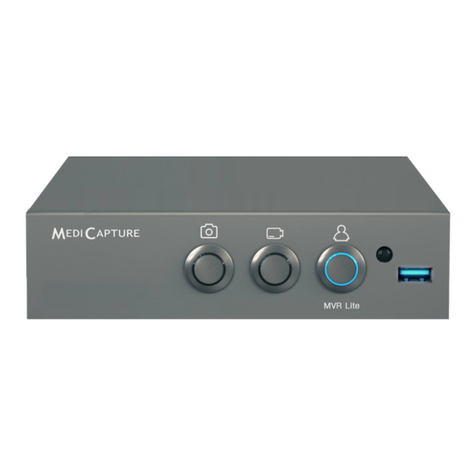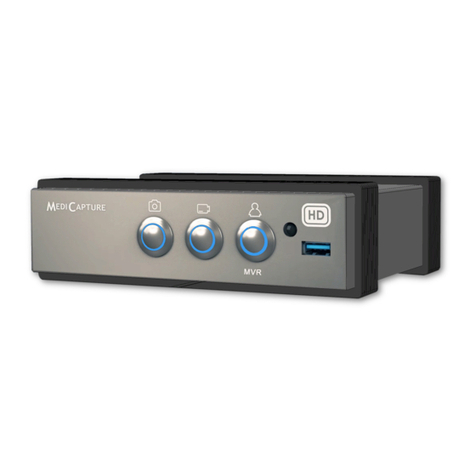MediCapture MediCap USB300 User manual

MediCap®
USB300
High Definition
Medical Video Recorder
User Guide
Applies to firmware 110701 and higher
USB300-UG01-EN-130815-MC

MediCap®USB300 User Guide –English
2 of 20 USB300-UG01-EN-130815-MC
Precautions for Use
WARNING:
To reduce the risk of fire or shock hazard, do not expose this equipment to rain or moisture.
CAUTION:
To reduce the risk of fire or shock hazard and annoying interference, use the recommended
accessories only.
CAUTION:
Do not use the images for diagnosis or evaluation purposes. The compression reduces the information
of the picture and is therefore not appropriate for diagnosis.
CAUTION:
The MediCap Medical Video Recorder is a Class I active medical device (Medical Devices Directive
93/42/EEC). It is important to observe your obligations as the operator of this medical device to ensure
its safe operation with no risk of danger to patients, users or third parties. If no other local law is
applicable, it is recommended that a safety and document test be performed at least once every 2 years
according to EN 62353. It is important to ensure that persons performing the safety check have the
necessary qualifications.
USA FCC CLASS A:
This equipment has been tested and found to comply with the limits for a Class A digital device, pursuant to
Part 15 of the FCC Rules. These limits are designed to provide reasonable protection against harmful
interference when the equipment is operated in a commercial environment. Like all similar equipment, this
equipment generates, uses, and can radiate radio frequency energy; and if not installed and used in accordance
with the operator manual, it may cause harmful interference to radio communications. Operation of this
equipment in a residential area is likely to cause interference, in which case you will be required to correct the
interference at your own expense.
CANADA ONLY / CANADA SEULEMENT
Caution:
This digital apparatus does not exceed the Class A limits for radio noise emissions from digital apparatus set out
in the Radio Interference Regulations of the Canadian Department of Communications.
Attention:
L’interférence radioélectrique générée par cet appareil numerique de type A ne dépasse pas les limites
éconcées dans le Règlement sur les perturbations radioélectriques, section appareil numérique, du Ministère
des Communications.
Disposal Method: Use your local regulations for proper disposal.

MediCap®USB300 User Guide –English
3 of 20 USB300-UG01-EN-130815-MC
Table of Contents
Quick Start......................................................................................................................5
Front Panel .....................................................................................................................5
Back Panel......................................................................................................................6
Typical Connections........................................................................................................7
Connecting the MediCap USB300...................................................................................8
Inserting a USB Flash Drive............................................................................................8
Recording Images...........................................................................................................8
Recording Videos............................................................................................................9
Reviewing Videos and Images ........................................................................................9
Creating Patient Folders................................................................................................10
Using the Menus...........................................................................................................10
Keyboard Control..........................................................................................................10
Main Menu....................................................................................................................11
Setup Menu...................................................................................................................12
Image Options Menu.....................................................................................................13
Video Options Menu......................................................................................................13
Advanced Options Menu...............................................................................................14
Patient Information Feature...........................................................................................14
Recording Destinations.................................................................................................15
Recording to a USB Flash Drive....................................................................................15
Recording to a USB Hard Drive.....................................................................................16
Hard Drive Formats ...................................................................................................16
Transferring Images from a USB Drive to Your Computer .........................................16
Recording to the Internal Hard Drive .............................................................................16
Accessing the Internal Hard Drive via a Network .......................................................17
Recording to a Network Drive........................................................................................17
Storage Management....................................................................................................17
Copying Videos from the Internal Hard Drive to a USB Drive.....................................17
Formatting the Internal Hard Drive.............................................................................17
Formatting USB Drives..............................................................................................17
Patient Review...........................................................................................................18
Viewing Still Images on Your Computer ........................................................................18
Viewing Videos on Your Computer................................................................................18
Internal Monitor.............................................................................................................18
Other Features..............................................................................................................18
Recording Images While Recording Videos...............................................................18
Footswitches and Camera Triggers ...........................................................................18
Printing......................................................................................................................18
Appendix A: MediCap USB300 Specifications...............................................................19
Appendix B: MediCapture Limited Warranty..................................................................20

MediCap®USB300 User Guide –English
4 of 20 USB300-UG01-EN-130815-MC
Important Safety Instructions
1. Read all of these instructions.
2. Keep these instructions.
3. Heed all warnings in these instructions.
4. Follow all of these instructions.
5. Do not misuse this apparatus.
6. Clean only with a dry cloth.
7. Do not block any of the ventilation openings. Install in accordance with the
manufacturer’s instructions.
8. Do not install near any heat source such as radiators, heat registers, stoves
or other apparatus that produces heat.
9. Do not tamper with the polarized or grounding-type plug. A polarized plug
has two types of blades with one being wider than the other. A grounding-
type plug has two blades and a third grounding prong. The wide blade or
third prong is provided for your safety. When the provided plug does not fit
into your outlet, consult an electrician for replacement of the obsolete
outlet.
10. Protect the power cord from being walked on or pinched especially near
plugs, outlets, and the point where the cord exits from the apparatus.
11. Only use attachments/accessories specified by the manufacturer.
12. Use only with a cart, stand, tripod, bracket or table specified by the
manufacturer, or sold with the apparatus. When a cart is used, use caution
when moving the cart/apparatus combination to prevent the cart from
tipping over and to avoid injury.
13. Unplug this apparatus during lightning storms or when unused for long
periods of time.
14. Disconnection Method: Switch off AC power by the rocker switch on the
rear panel, disconnect power cord.
15. Do not place vessels containing water or other liquids (such as vases, etc.)
on top of the apparatus. Do not splash water on top of the apparatus.
16. Refer all servicing to qualified service personnel. Servicing is required
when the apparatus has been damaged in any way, such as when a power
supply cord or plug has been damaged, liquid has been spilled on the
apparatus, objects have fallen into the apparatus, the apparatus has been
exposed to rain or moisture, or does not operate normally, or has been
dropped.

MediCap®USB300 User Guide –English
5 of 20 USB300-UG01-EN-130815-MC
Quick Start
The MediCap®USB300 records video and images from virtually
any medical video device (endoscope, arthroscope, surgical
microscope, ultrasound, etc.). You can record in high definition
(HD) or standard definition (SD). Your recordings can be saved to
a USB drive, the internal hard drive, or a network drive.
To get started:
1. Connect the USB300. A typical setup is shown on page 7. Turn on
the unit (use the power switch on the back and the Power button on
the front). You will see live video on the monitor.
2. Insert the supplied MediCapture USB flash drive in the front panel.
1
3. Use your imaging equipment as you always do, except now you can
record images and video while you work. To record images, press
the Record Photo button. To start a video recording, press the
Record Video button; press it again to stop.
4. When you finish recording for the current patient, press the New
Patient button. This will store the next patient’s videos in a new
folder.
5. Remove the flash drive from the USB300 and insert it in the USB
connector of a computer. You can move the images and videos that
you have just recorded to your computer for viewing, archiving, etc.
Important Note: This document applies to USB300 units running firmware version 110701 and
higher. If this document was shipped with your USB300, it applies to your unit. If you are viewing
this document online, please check your firmware version (use the Current Settings option in the
Advanced Menu). For documents that apply to earlier firmware, see medicapture.com/support. For
help upgrading firmware, please send an email to support@medicapture.com.
Ordering Information
MediCapture recommends MediCapture® brand USB flash drives. Please visit medicapture.com for information
on how to purchase flash drives.
Technical Support
For technical support and other questions, please visit medicapture.com or call 888-922-7887 (toll free from
within the USA) or 503-445-6935 (from outside the USA).
MediCapture®Inc.
2250 Hickory Road, Suite 200,
Plymouth Meeting, PA 19462
EC
Representative:
Obelis, SA
Bd. General Wahis 53
1030 Brussels, Belgium
1
If you are a new user, start by recording onto a USB flash drive. Later, after you have become
familiar with the unit, you may want to record to the internal hard drive or a network drive. See
page 15 for information about recording destinations.
Note: If the picture on your
monitor is “stretched”,
ensure you have selected
the proper resolution.
Press “Menu.” Use the
arrow and “Select” buttons
to go to “Setup” > “Output.”
Important: Set the clock
so your recordings are
labeled with the correct
time. Press “Menu,” go to
Setup, select Date/Time.
To ensure the clock
remains accurate, leave
the Master Power
Switch on the back
panel ON at all times.
You can use the Power
button on the front panel
to turn the unit on and off
during daily use without
affecting the clock.
Table of contents
Other MediCapture DVR manuals



















